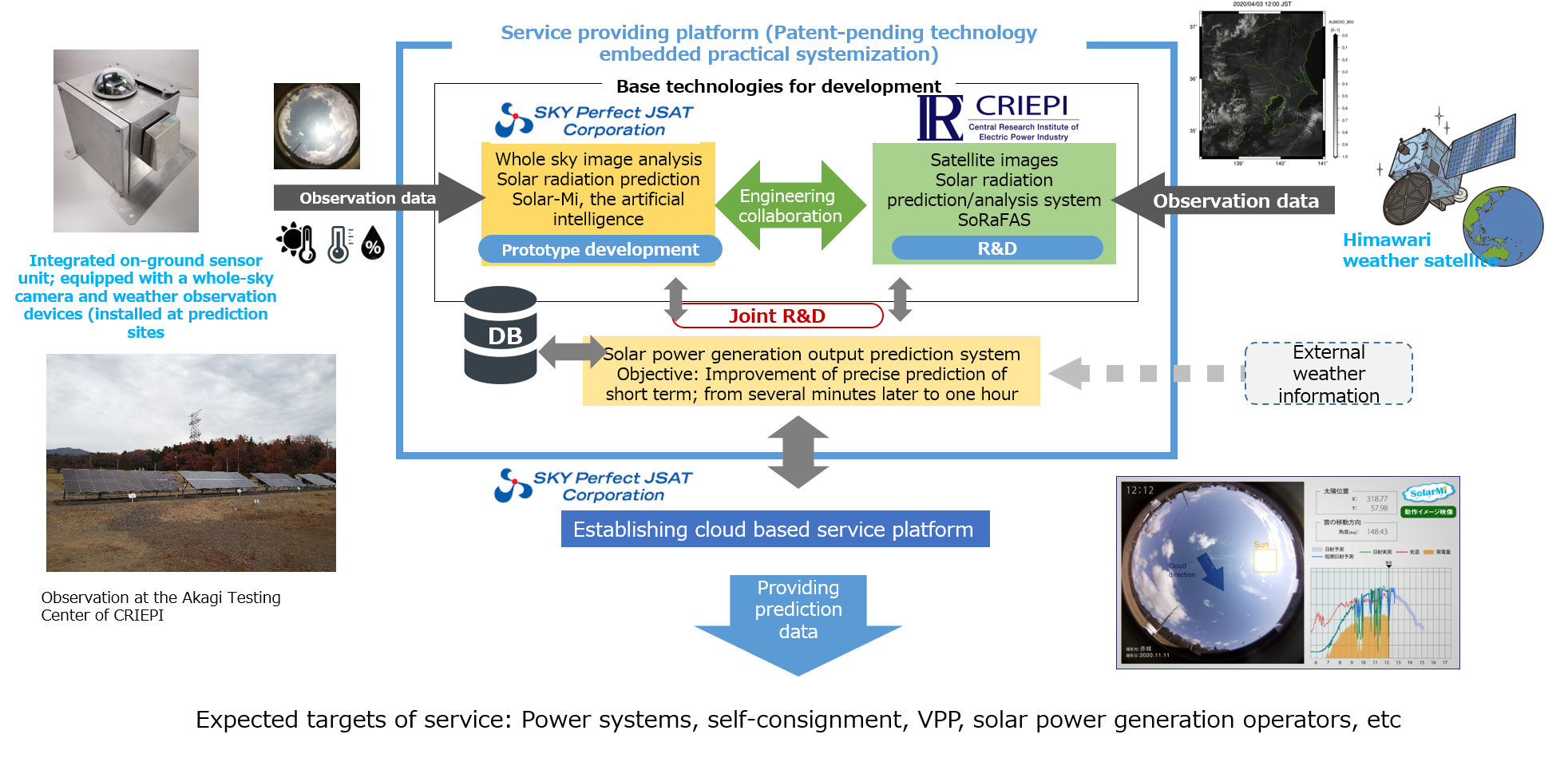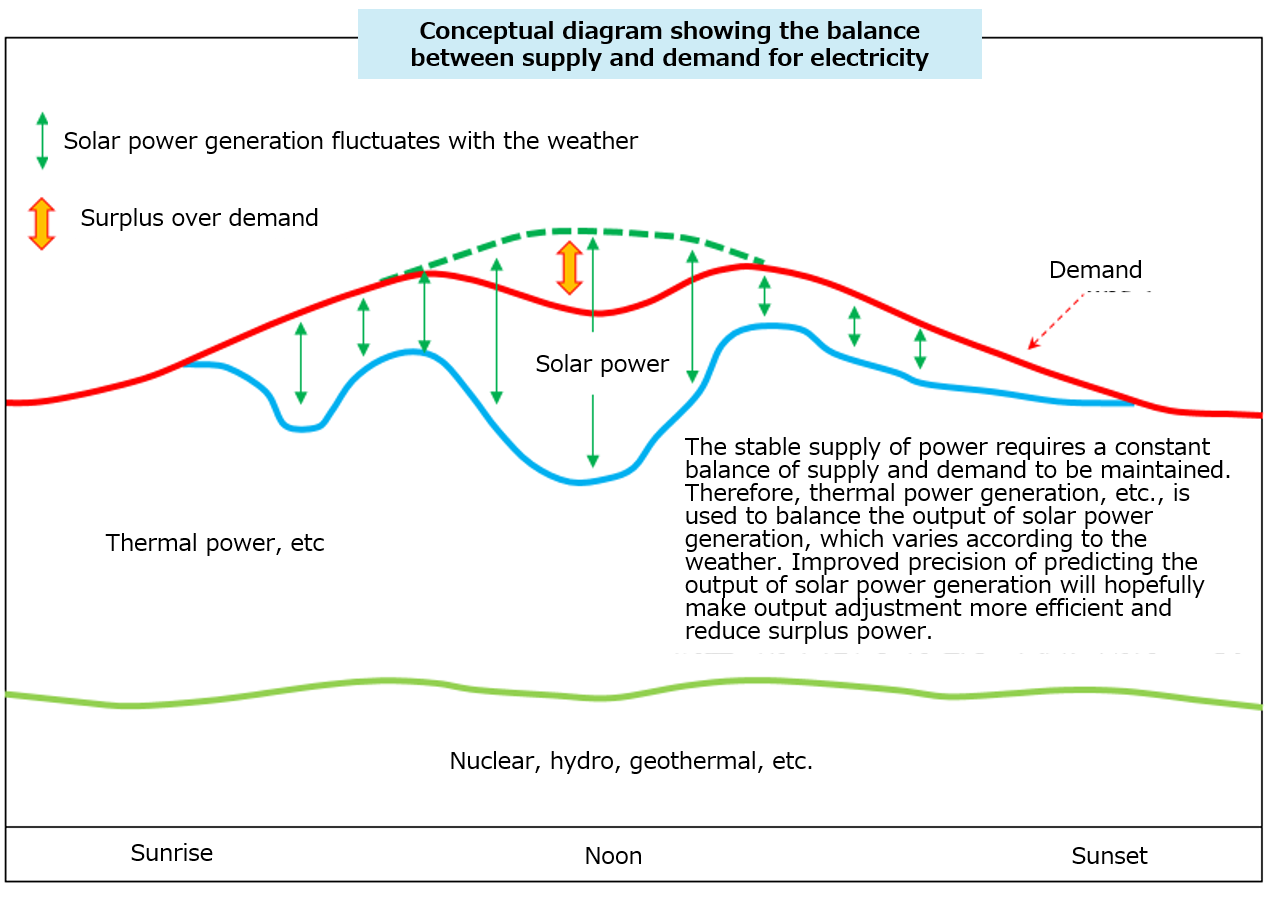- News Releases
- SKY Perfect JSAT Corporation
- Central Research Institute of Electric Power Industry/SKY Perfect JSAT Creating Methods for Forecasting Solar Power Generation Output
News Releases
Central Research Institute of Electric Power Industry/SKY Perfect JSAT Creating Methods for Forecasting Solar Power Generation Output
Dec 3, 2020
The Central Research Institute of Electric Power Industry (Head Office: Chiyoda-ku, Tokyo; President: Masanori Matsuura; "CRIEPI") and SKY Perfect JSAT Corporation (Head Office: Minato-ku, Tokyo; Representative Director, President & Chief Executive Officer: Eiichi Yonekura; "JSAT") have agreed to conduct joint research on a Hybrid Solar Power Generation Output Prediction System (Hybrid Prediction System) with utilizing artificial intelligence, satellite images, and the whole-sky images retrieved by integrated ground sensors. Tracking cloud movement from cloud images retrieved from both the space (via satellite) and the ground (via integrated ground sensors) improves the precision of solar power generation output prediction from several minutes to one hour in the future, which was technically difficult to achieve in the past. CRIEPI and JSAT plan to systemize this technology and start a solar power generation output prediction service with enhanced short-term prediction in 2022.
<Overview of Technical Development and Scope of Application>

In order to stop global warming, it is necessary to reduce the CO2 emissions on human activities to net zero. Around the world, more than 120 countries are aiming to achieve net zero emissions by the year 2050, and the Japanese government has also declared that Japan aims to achieve a decarbonized society and be carbon neutral by 2050. Looking ahead to a decarbonized society, renewable energy is expected to become a major power source. The adoption of solar power generation has been rapidly increasing since a feed-in tariff scheme for renewable energy started in July 2012, and future expansion of its use gains attention. Because the output of solar power generation greatly fluctuates with changes in the weather and cloud coverage, high precision prediction is one of the important issues that the stable supply of electricity faces.
In order to solve this issue, CRIEPI and JSAT are conducting joint development of a hybrid prediction system that combines their unique technologies of satellite prediction and integrated ground sensor prediction. More specifically, this new system aims to improve the precision of predicting the output of solar power generation from several minutes to one hour in the future by combining the technologies of the SoRaFAS system developed by CRIEPI to predict/analyze solar radiation via satellite images, and the short term prediction system developed by JSAT that consists of integrated ground sensors, whole-sky image analysis and SolarMi artificial intelligence.
CRIEPI has been conducting various types of research regarding the adoption and use of renewable energy, and their efforts have provided technologies to customers such as power companies. In particular, the institute has been promoting the application of weather prediction technologies in the field of renewable energy. Looking toward the prediction of solar power generation output, the institute has been developing the SoRaFAS system for predicting and analyzing sunlight based on image data retrieved by the Himawari-8 geostationary weather satellite operated by the Japan Meteorological Agency. This system targets the service areas of power companies and automatically predicts and analyzes solar radiation and solar power generation output up to six hours in advance.* 1
Co-developer JSAT has been developing the KMOMY artificial intelligence system for analyzing clouds since 2017. Some of the functions of the system are provided free-of-charge as a part of the Kumolog smartphone app, which recognizes captured cloud images to display the shapes (names) of clouds based on World Meteorological Organization (WMO) definitions.* 2 JSAT is developing the SolarMi artificial intelligence system for short-term solar radiation prediction by applying the technology of KMOMY, which has a cloud recognition precision of 85% or higher, and aims to combine the system with the prediction system of CRIEPI to achieve high-precision solar radiation prediction.
In developing the hybrid prediction system, CRIEPI and JSAT have jointly applied for a patent regarding technology for combining satellite images and the whole-sky camera images of integrated ground sensors with cloud type recognition technology in order to identify the clouds in images and the state (size, height, elevation, and thickness) of those clouds and thereby track the movement of the identified clouds. Being able to predict the movement of clouds means that variation in solar radiation can be predicted, and that data can then be combined with information on solar power generation capacity to predict the output of solar power generation.
<Overview of Sunlight Prediction at the Akagi Testing Center of CRIEPI (Under Development)>

Since the output of solar power generation greatly fluctuates with the weather, adjusting the balance of supply and demand is important for the stable supply of power. On the other hand, leveraging solar power generation effectively is essential to achieving decarbonization. Achieving both of these objectives appropriately requires precise prediction of the output of solar power generation.
CRIEPI aims to contribute to stabilizing the balance between supply and demand of regions and power systems, by building technologies for the high-precision and high-resolution sub-hour prediction of solar radiation and solar power generation output in regions and sites, based on the recent joint research and development of technologies.
JSAT has started providing a highly precise solar power generation output prediction service based on the recent jointly developed technology, and JSAT aims to develop the business as a platform together with Japanese power companies and other power related industries. The company also aims to achieve some of the UN Sustainable Development Goals such as Goal 7: Ensure access to affordable, reliable, sustainable and modern energy for all, Goal 9: Build resilient infrastructure, promote inclusive and sustainable industrialization and foster innovation, and Goal 13: Take urgent action to combat climate change and its impacts through these activities.* 3
While contributing to maintaining the stable supply of electricity, both CRIEPI and JSAT aim to adopt low-carbon power sources for achieving decarbonization by reducing surplus power resulting in utilizing effective solar power generation.
*1 https://criepi.denken.or.jp/research/news/pdf/den485.pdf
*2 https://www.skyperfectjsat.space/news/files/pdf/news_sjc_jp_20181030_02.pdf
*3 The SDG that JSAT aims to achieve via this business
